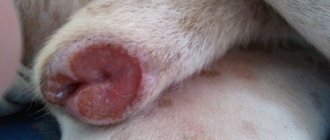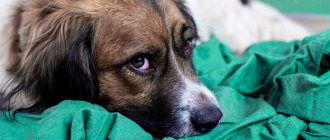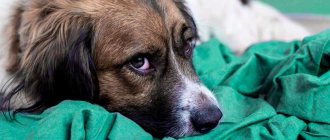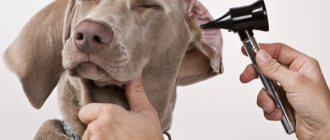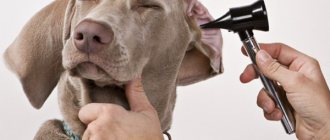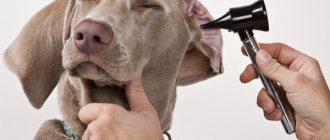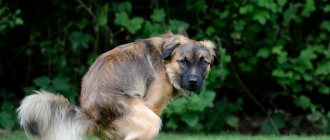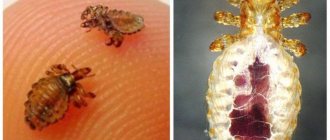Lice eaters in dogs are a type of external parasite that is not very well known to pet owners. This is because these translucent small insects are very difficult to detect on the animal’s body. The food for these ectoparasites are particles of the epidermis, dried blood and dog fluff, which is why they are also called lice beetles, skin beetles or itches. Infestation by lice eaters is scientifically called trichodectosis. You need to know all your dog’s “enemies” by sight in order to detect them in time and begin to fight them. In this article we will talk about where a dog can become infected, how to identify parasites and how to deal with them. Let's consider popular industrial and folk remedies and preventive measures.
Lice eaters in dogs and what they look like
Lice-eating lice are classified as lice that parasitize four-legged pets. The length of these yellowish-gray insects is no more than 2 mm even after maturing to a sexually mature individual. When viewed with the naked eye, they can easily be confused with regular dandruff.
Unlike other lice, lice are wingless. They cling to their host with hook-shaped jaws and strong claws. These parasites feed on keratinocytes, that is, hair and skin cells.
Hair lice are striking in their fertility. One individual can lay up to 100 eggs, which go through the entire development cycle in just 28 days. Without timely treatment, the colony of parasites grows rapidly, causing severe itching in the infected animal.
Appearance of the parasite (photo)
The lice beetle belongs to the order of lice and lice. This is a very small insect with a flat body. The length of the parasite is about 1 mm, the color ranges from grayish, transparent to yellow. On the skin of an animal, the lice eater looks more like particles of dandruff than a parasite.
The body of the lice eater looks very much like a louse or a flea, but there is one distinctive feature - the shape of the head. In the lice eater it is wide, wider than the body. The parasite feeds not only on blood and lymph, but also on particles of skin and fur.
The lice beetle reproduces very quickly. The female lays about 70 eggs during her life cycle, which are attached to the animal’s fur using a sticky liquid. After about a week, larvae emerge from the eggs, which only a month later become adults, having previously gone through three stages of molting.
Difference from other ectoparasites
The symptoms and methods of treating scabies mites, lice mites and fleas in dogs are similar, but the differences between these ectoparasites are clearly visible in the photo. The size of the lice beetle is much larger than that of a tick, and its head is wider than a flea.
Another difference is the way they eat. Hair lice live strictly on the surface of the skin, and their mouthparts are not adapted for sucking blood. Despite this, they happily feast on the lymph that appears from the wounds as a result of scratching.
Due to the lack of wings and poor jumping ability, lice eaters do not strive to leave the body of their owner. This distinguishes them from fleas, which love to savor different types of blood and often move on to new victims.
Folk remedies
Treatment of a pet with folk remedies is also acceptable. However, it is better to use them in combination with drops or shampoo. Decoctions of wormwood, string and chamomile are suitable. You need to bathe the animal in them, thoroughly washing the fur down to the very base.
Substances contained in herbs negatively affect the vital activity of lice eaters, which forces them to leave the animal’s body.
Protecting your dog from lice eaters is quite simple. Avoid contact with stray dogs, change the bedding more often and bathe it at least once a week. The owner should regularly examine the pet's skin and, at the first sign of the presence of parasites, take measures to eliminate them.
Danger of infection and complications
Any pet can become infected with trichodectosis, so the patient must be isolated during treatment. Despite this, direct transmission of parasites occurs only some time after infection. Until this moment, small pests are in no hurry to change their owner.
It is also worth noting that a dog's lice eater is different from a cat's. Each of these ectoparasites gravitates toward a specific type of animal and tends to leave the body of the “wrong” host. If there is a cat living in the house, then the greatest danger to it is not the lice eater, but the diseases it carries.
Thanks to their “gnawing” mouthparts, lice lice remain undetected for a long time. Their bites are not as painful as those of fleas, so the symptoms of infection at the initial stage are almost invisible. For this reason, trichodectosis is often complicated and leads to:
- secondary infection with fungi and bacteria that freely penetrate combed wounds;
- allergies provoked by waste products of pests;
- exacerbation of chronic pathologies arising from a weakened immune system;
- exhaustion and anemia;
- helminthic infestations that develop when eggs and larvae of helminths are transmitted through lice beetle bites.
The last complication is observed more often than others. The thing is that when biting the itchy areas, the helminths go straight into the mouth.
The danger of trichodectosis
Having settled on the body, the dog's hair eater begins active life activities, causing severe itching. This causes the animal to constantly scratch its skin. The consequences of injury are different. In addition to scratches and irritation, complications such as eczema or dermatitis are possible.
Lice eaters are dangerous. Insects are carriers of infections and internal parasites, in particular tapeworms and helminths. Pathogenic microorganisms easily penetrate open wounds and provoke various diseases. Lice eaters cause a fungus, leptospirosis.
Trichodectosis suppresses the immune system, which makes it difficult to resist negative environmental factors. The dog begins to get sick often, chronic pathologies worsen, and allergic reactions appear.
Insects do not take root on humans, even on the scalp. The body temperature of humans is lower, and the cover is not suitable for the life of individuals. However, it is best to avoid close contact with an infected animal. There is a possibility of an accidental bite and infection entering open wounds.
Routes and sources of infection
The main mechanism of transmission of the pathogen is contact. Lice eaters appear in puppies from an infected mother, since in the first 2 months the babies are under strict quarantine. In adulthood, infection occurs through sexual contact, licking, sniffing, fighting and playing together.
In addition to direct contact with a sick animal, an indirect transmission mechanism is also possible, that is, through hygiene items, toys, dishes and outdoor shoes.
Infection through rodent carriers is even less common. Cats that hunt mice and rats are usually infected in this way.
The risk group includes residents of dog shelters. Due to the crowded conditions, only one infected person is enough for a mass epidemic. Also, the likelihood of infection increases a weak immune system due to
:
- high level of humidity, increasing the pathology of the respiratory system;
- poor diet;
- immunodeficiency;
- too young or old;
- neglect of hygiene.
Trichodectosis is characterized by seasonality. The greatest activity of parasites is observed in autumn and winter.
Are lice eaters dangerous for humans?
Despite the fact that lice eaters feed on blood, they do not pose any danger to humans. Parasites that live on a dog’s body are not transmitted even to cats and vice versa.
To maintain vital functions, the lice eater needs a blood and body temperature higher than human.
Lice eaters are very unpleasant inhabitants of dog fur. But with proper hygiene and attention to your pet, such an unpleasant disease can be avoided. To have peace of mind for your pet, you need to regularly prevent the disease.
5 / 5 ( 1 voice )
Main symptoms
Despite the mild symptoms and small size of the pathogen, an attentive owner can easily detect it. The main changes concern the behavior and appearance of the dog. These include:
- loss of activity, poor appetite and irritability;
- intense itching, affecting the quality and duration of sleep;
- the appearance of dandruff and deterioration in the quality of wool (fragility, the appearance of tangles) as a result of active exfoliation of the epidermis;
- focal hair loss at the base of the tail, on the inner thighs, head and ears, accompanied by inflammation and redness of bald spots.
If you notice these symptoms, be sure to do a small test. Point the switched-on lamp at your pet and warm its skin for 10 minutes. Pooh-eaters love high temperatures, so they will definitely get closer to a heat source. At this point they can be seen under a magnifying glass.
Once you are sure you have trichodectosis, immediately make an appointment with your doctor. All insecticidal preparations are very toxic, so their dosages and duration of administration are selected individually.
Clinical picture
When a lice eater is detected, the following signs appear:
The appearance of small white elements resembling. Ungroomed appearance of the coat. Sharp weight loss. Severe anxiety. Distracted attention. Behavior change.
The lice eater causes itching in dogs.
The dog may itch severely for several days. Hair falls out so profusely that baldness occurs as a result.
The skin at the site of baldness swells and becomes wrinkled. It becomes covered with a gray crust. And also specific scabs are found on the skin.
The dog becomes very nervous and may stop listening to commands.
How to get rid of lice in dogs
After taking a scraping, the veterinarian determines the severity of the disease and explains how to treat lice in dogs. At the initial stage, they limit themselves to insecticides, and at an advanced stage, they add antibiotics and antimycotics that fight secondary infection.
Treatment with insecticides is carried out twice. At the first stage, all adult individuals are killed, and at the second, the larvae hatched from the eggs.
Shampoos
Shampoo is the most gentle type of insecticidal preparations, but this is also its disadvantage. It washes off too quickly, so it is effective only for mild forms of trichodectosis. In addition to destroying the pathogen, it improves the condition of the coat and relieves itching.
Sprays
Spray the spray directly onto the coat, avoiding licking the product until completely absorbed. Otherwise, the pet may be poisoned. Direct inhalation should also be avoided. To do this, it is recommended to use a protective mask during processing.
Drops
The most common form of anti-lice preparations for dogs is drops. They are made from natural oils or chemicals that kill parasites.
Another feature of this product is its long-lasting effect. When applied to the skin, it protects the animal from pests for 2 months.
Ointments
For frequent use in case of extensive damage, ointments are prescribed. They are applied twice a day after shampooing. Such drugs are characterized by the least toxicity and rarely cause allergies.
Pills
The duration of action of the tablet form is up to 3 months. When the tablet is swallowed, the active substances enter directly into the blood, so the parasites die soon after the bite.
Collars
Insecticidal collars are effective in preventing trichodectosis, flea and tick infestations. To repel parasites, they are impregnated with special chemicals, which often causes allergies. In case of hair loss and redness of the skin at the contact site, it is recommended to replace the collar with a safer analogue.
Folk remedies
Folk remedies for hairworms for dogs include various herbal decoctions based on string, chamomile and celandine. A sick pet is bathed in them until the symptoms disappear. This method of treatment is suitable for puppies and animals with sensitive skin who are not allergic to the listed plants.
Symptoms of canine lice infestation
The clinical picture of trichodectosis resembles the symptoms of infection with fleas, lice and ticks:
- Severe itching of the skin. The animal tries to relieve the itching by scratching itself.
- Changes in coat structure. Dog hair loses its shine and sticks together. The dog looks disheveled.
- Hair loss. Complete baldness is possible on the tail, inner thighs and muzzle.
- The skin in areas of bald patches becomes rough, red, and crusty.
- On the dog's fur you can notice small white grains that move.
- Dermatitis in areas scratched by the dog.
- Extreme thirst and loss of appetite.
- Behavioral changes: sleep disturbances, aggression, anxiety, loss of attention.
- Decreased immunity.
- Delayed growth and development (in puppies).
Why is trichodectosis dangerous for a dog?
Causes functional disorders in the animal's body.
- Reduces immunity.
- Weakens the skin barrier function.
- Causes complete baldness of the dog.
- The causative agents of the disease are carriers of leptospira, fungi and helminth eggs.
Due to the fact that the clinical symptoms of many parasitic diseases are similar, it is important to correctly diagnose.
Dosage and use of medications
The treatment course takes at least a month, so it is very important to follow all the veterinarian’s recommendations. If you neglect treatment until all parasites are destroyed or exceed safe dosages, you can harm your pet.
When using medications, be sure to adhere to the following rules:
- Do not rush to wash off shampoo applied to wet fur. The effect appears only after a few minutes, so rub it thoroughly into the skin and leave it there for a while. Pay special attention to heavily soiled areas with tangles. They require more detergent to clean.
- After rinsing off the shampoo, dry the coat thoroughly and comb it through with a comb. This will help get rid of a significant part of the pests.
- When spraying sprays, try to avoid getting them into the eyes and other mucous membranes.
- Apply drops strictly to the withers or along the line of the spinal column. In these areas, the animal will not be able to lick them, but for safety it is better to wear a protective collar.
The treatment is carried out in several stages with a weekly or two-week interval. If the symptoms disappear almost immediately, do not rush to rejoice and cancel the prescribed medications until you are re-examined at the veterinary clinic.
Prevention
Preventive antiparasitic treatment of a dog and its habitat is not reinsurance, it is a way to save your pet from a severe debilitating disease.
Prevention measures:
- Barrier. Try to protect your dog from unwanted contact with stray animals.
- Antiparasitic collar. Use special collars when walking your dog.
- Animal hygiene. Keep your dog's environment clean and bathe your dog regularly. Wash and replace bedding promptly. Carry out preventive treatment of enclosures, kennels and dog habitats with insectoacaricidal agents.
- Visual inspection. Regularly carefully inspect the body and coat of the animal.
Following these simple rules will help protect your pet and you from the harmful effects of parasites.
Important! Remember that it is easier to prevent an infection than to treat a dog for a difficult-to-treat infestation.
Handling your pet's personal belongings and disinfecting your home
Leaf bugs that have left the fur can hide in any household items, so the fight against them cannot be done without thorough disinfection. All horizontal surfaces must be treated with insecticides or herbal infusions.
Particular attention should be paid to dog toys and bedding. They should be washed in hot water with insecticidal shampoo or treated with steam, and then thoroughly frozen on the balcony. In summer, the required temperature can be found in the freezer. To destroy heat-loving pests, it is enough to keep washed items there overnight.
Photo gallery
Photo 1. Lice eater under a microscope
Not all owners know that lice in dogs can lead to death. You won't know what lice eaters look like because they are microscopic, but you can notice the symptoms and signs of infestation.
This is interesting! Unlike their cousins, lice eaters can easily tolerate extreme temperatures and have been found in both hot and cold regions.
Are lice-eaters transmitted to humans from dogs?
Quite often, instead of making a correct diagnosis, the pet is treated for atopic dermatitis or of unknown origin. If you doubt the correctness of the diagnosis, it is better to take skin scrapings yourself and submit them to a “human” laboratory for diagnosis. This measure is especially wise if you live in a region where lice eaters are not widespread.
Unfortunately, lice-eater infestation in itself is not as dangerous as its consequences. Irritated, affected skin becomes fertile soil for fungi and microscopic mites. Usually, the first rebel is Demodex, which lives on the skin of healthy dogs.
Weeping wounds are accompanied by infection, which gives the disease a purulent character. Typically, at this stage, the dog's skin is so damaged that it does not fully recover. Without treatment, the animal dies.
The course of treatment can range from 14 to 40 days, depending on the degree of skin damage.
During the entire recovery period, the dog is given supportive therapy and symptomatic treatment. To recover, your pet needs rest and quality nutrition.
Due to constant itching, the dog develops anxiety and sleep disturbances, which leads to chronic fatigue and a decrease in the body's immune defense. To relieve this situation, the dog is prescribed immunostimulants.
Folk remedies for the treatment of lice in dogs
Treatment and medications you will need depend on the extent of the skin damage. Practice shows that when the lesion is at an advanced stage, it is practically impossible to restore hair growth.
When the body's immune defense decreases and the temperature rises, it is almost guaranteed that the dog will develop demodicosis. The pathogen, which lived peacefully on the skin of a healthy dog, begins to actively multiply and infect large areas of the skin.
Depending on the type of pathogen, demodicosis can occur on the dog's paws, face and body. Treatment is extensive and complex. Usually the dog is treated several times with potent insecticide preparations.
In parallel, injections of antibiotics and antifungal drugs are given to prevent the situation from worsening. Treatment of demodicosis can last for months. Hair restoration is also questionable.
In the early stages of the disease, the reaction to toxins is expressed by dermatitis and severe itching. If left untreated, the dog will scratch the skin, which leads to wound infection, swelling, severe pain and the formation of pus. At this stage, broad-spectrum antibiotics and comprehensive supportive therapy are used.
If the blood is damaged, recovery is impossible without therapy that supports the liver and kidneys. Usually, the kidneys are the first to suffer, which affects the functioning of the genitourinary system. The dog may experience uncontrollable thirst, low-concentrated urine, and pain on palpation in the spine and hip joints.
Drops are considered the most reliable and convenient means of prevention. Typically, drops protect against fleas, ticks and lice
Some medications also protect your dog from mosquitoes, which is important if you live in a region where dirofilariasis is common. If you carefully read the instructions for the drops, you will find that they protect against fleas 2 times longer than against ticks
Since lice eaters are arachnids and belong to the family of mites, to prevent them, the dog must be treated more often.
Practice shows that the most effective drugs protect a dog for no longer than one month. For reliable prevention, your pet needs to be treated regularly all year round. The frequency of treatments can be reduced in winter, especially in frosty weather.
Preventative collars were invented to combat fleas and ticks; they do not particularly help against lice and subcutaneous ticks. Insecticides, which are released from the collar gradually, are absorbed into the skin and spread over its entire surface.
Where can a dog get infected?
Most lice-eater infestations occur in winter. Domestic dogs can become infected while walking or through contact with an infected animal. Also, family members can bring the lice beetle larva home, for example, on shoes.
Hunting dogs are especially susceptible to infection, since lice eaters can live on the fur of wild animals, therefore, the forest is a place of infection.
Lice eaters can travel quite long distances, so your dog can become infected from a neighbor's dog, even if they have no contact with each other.
Preventive measures against infection
The rules for keeping an animal are simple, but require systematic adherence. Only the regularity and consistency of the owner’s actions will help minimize the risk of lice-eater infection:
- Bathing your dog should be regular and use special shampoos.
- Constant cleaning, washing and tidying up the bedding for sleeping, the enclosure, and the pet's kennel.
- Treating the place of residence to prevent insects (you can use pharmaceutical ones, or you can use folk remedies: dried wormwood, laid out in bunches near the booth or in bags near the bed).
- Limit the contact of the ward with homeless animals.
- Conduct regular examinations of skin and hair.
- Wear your pet a parasite collar on a regular basis.
The best thing that can happen in a dog's life is to find a caring, loving owner. If your pet is lucky, and you are, then he will always remain healthy, vigorous and happy.
Diagnosis and treatment
You can suspect otodectosis at home; just examine the inner surface of the ear. But a veterinarian must confirm the diagnosis based on signs and microscopic examination of scrapings.
Therapy is not difficult; there are a lot of drugs that are effective for otodectosis:
- Anandin (3-5 drops in each ear, 1 time per day for a week).
- Amitrazine (1-2 ml every three days).
- Bars, Otovedin (3-5 drops every 3-5 days).
- Spray Bars (2-3 sprays on each ear, once every three days).
- Ivermek gel (1-2 cm of gel is applied once every 5 days twice to the affected ear, rubbed).
- Tsipam (3-5 drops in the ears every 5 days).
You will have to be treated with crowbar, carefully following the veterinarian’s instructions. A standard mistake of all breeders is not thoroughly cleaning the ear before using medications.
Sequencing:
Contents of the ears with otodectosis
- Using cotton swabs soaked in ear cleaning lotion (approx. Bars), carefully remove all dark plaque. If the process has gone deep, you need to get the oily substance out as far as possible without damaging the eardrum. The pet will fiercely resist, but manipulation is necessary.
- You cannot use hydrogen peroxide or alcohol for cleaning, they dry out already inflamed skin. In the absence of lotion, it is permissible to use sea buckthorn oil, any oil (not petroleum jelly), or, as an option, the anti-otodectosis drops themselves.
- Apply drops, press the ear, massage it slightly. You should not let your pet go immediately after using the drops; he will start shaking his head, wiping himself on objects, and the medicine will not have time to be absorbed.
- It’s a good idea to use a cotton swab dipped in the preparation to coat the entire ear from the inside, including healthy tissue. This way you can prevent the “spreading” of ticks.
Sofradex drops relieve the inflammatory process well; they are sold in human pharmacies. All manipulations are done daily for the first 5 days. Next, cleaning is carried out every other day or two, until complete healing. There are no folk remedies for the treatment of otodectosis in dogs. Herbs of chamomile and sage have anti-inflammatory properties; they can be used to wipe inflamed skin before instilling drops. But decoctions have no effect on ticks.
External signs and behavior of the pet
At the initial stage of the pathological process the following appear:
- Weakening of the immune system. The pet constantly gets colds and becomes vulnerable to bacteria and viruses. His physical activity decreases, interest in walks disappears.
- Psycho-emotional state disorder. The dog experiences constant stress, which causes its behavior towards its owner and other pets to change. She becomes irritable, shows aggression and disobedience.
- Deterioration of condition and hair loss. Due to the biting and activity of parasites, bald spots are formed along the spine, at the base of the tail, groin area and on the face. The hair becomes dull and the dog may look disheveled. The owner discovers dense spherical particles. This is how the dog lice eater lays eggs.
- The presence of constant itching, which gradually intensifies.
- Developmental delay. Occurs in puppies through a vertical route of infection.
As the pathological process progresses, the affected areas of the skin become completely hairless. Due to scratching and infection of wounds, purulent ulcers form.
Stress provokes refusal to eat and sleep disturbances. If left untreated for a long time, bald areas become infected and a secondary dermatological disease develops.
Hair loss and deterioration in your pet's general condition indicate the presence of a disease.
